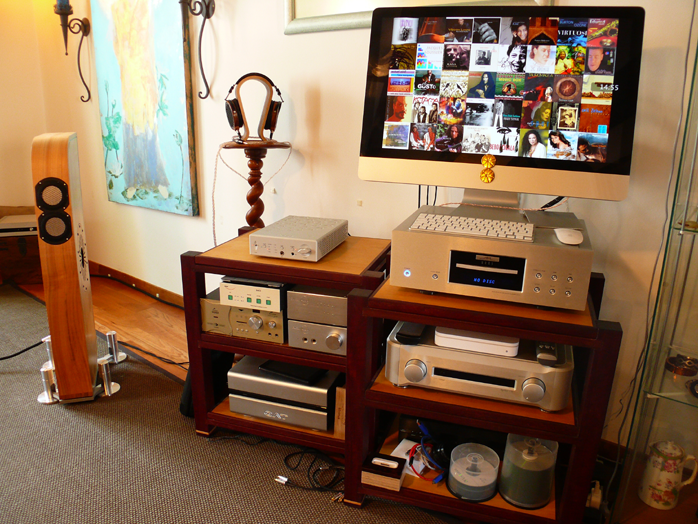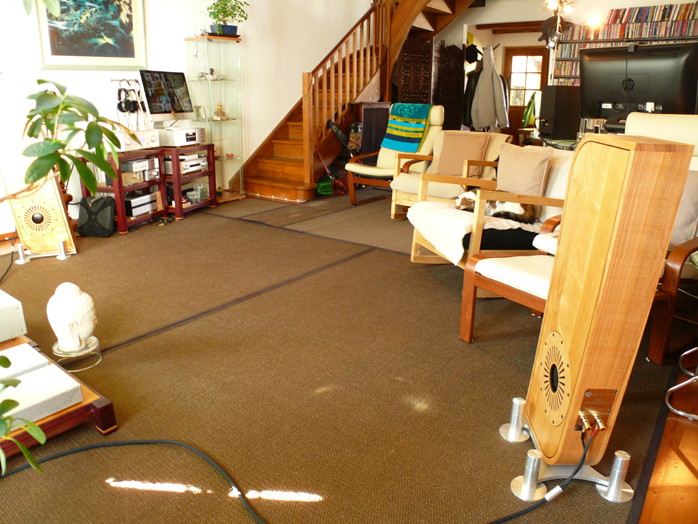This review page is supported in part by the sponsors whose ad banners are displayed below |
 |
 |
Sven Boenicke's B10 is a furniture-grade uniquely shaped speaker with opposed yet offset sidefiring 10-inch woofers. All that occupies the ultra-narrow sloping front are twinned 4-inch flat-cone widebanders. The entire crossover consists of one very exotic cap and resistor on the mid/tweeters. At about 87dB sensitivity the SIT2 amp needs just a few more clicks on the volume control than with the Gladius to produce room-filling levels. Even so the twin woofers loaded into a small sealed enclosure clearly thrive on more power. Hence the ModWright is my go-to amp for the B10. With the Eximus strapped to mono I expected a fine match (incidentally Boenicke's own amp of choice is based on an Italian Powersoft class D module).
|
 |
The prior distinctions between KWA-100SE and S1 held—no real surprise there—but their scope diminished. Invoking the first-watt credo for a prediction would only have suggested more of the same. Here getting out of first gear for an automobile torque analogy seemed more à propos to perhaps explain the reduced offset. Not only was the load more demanding, the B10 also requires slightly higher SPL than the Gladius to blossom (the latter behaves very much like a high-efficiency widebander in that regard). Without the comparator amp as reminder, the softened treble/transient/color effects no longer telegraphed per se. While the general performance remained obviously smooth and round, I don't think many listeners would have faulted it still for being too smooth. Inserting the ModWright now would simply have introduced an alternate somewhat livelier more lit-up flavor. But the difference now was sufficiently minor to be just that - flavors rather than right or wrong. Did this suggest that the Eximus might be happiest into more demanding loads to actually tap some of its power reserves?
|
|
|
Eximus x 3. Replacing the 6SN7-powered ModWright preamp with the DP1 stable mate (still fed from the NWO-M's analog outputs) turned the S1 into the KWA100-SE for all intents and purposes. The musical fabric became more quicksilvery and performers grew more tacit against surrounding space. Valve aficionados with ill-disguised suspicion about class D will be surprised—I was—but the S1 sounded more properly alive and colorful with this €3.000 transistor preamp. My progression towards the live vibe climaxed when I finally fed the DP1 digitally to eliminate the transformer-coupled valve output stage of the NWO-M. This was a reasonably dramatic uptick. It felt a bit like blowing open space whilst moving the microphones closer to the musicians to heighten immediacy. Now things really were cooking.
|
 |
Rather than invalidate my prior findings, this came full circle to proper component matching and the absence of any audio absolutes. The simple fact was that the S1 didn't need any valve coddle to come on song. It asked for leaner faster brighter transistors! Admittedly not an intuitive assessment—at least not to me—it nevertheless stared me straight in the ears. For verification I returned to the Gladius. Voilà. Suddenly here too I had string rasp, reed spittle and vocal croak for those textural micro inflections which make all the difference. The energetic damper I'd tried to eliminate had little if anything to do with the load and all with copasetic ancillaries. 'twas time to reintroduce the SIT2 but this time without the NWO-M and LS-100 which are its favorite playmates to pad down its ultra reflexes and flesh out its frame a bit.
Whilst still more endowed on rasp, spittle and croak as well as spatial depth, the SIT2 now had grown a little lean for my tastes. I'd either want the LS-100 or NWO-M back in the loop. With the S1s meanwhile things were just right on those counts. Shorting tintinnabulation in trade was a very minor issue. Both presentations felt equally valid. While an A/B still identified favorite aspects, those were evenly spread. Time to compare stereo and mono S2 now that the signal chain was fully supportive.
|
 |
In bridged mode the XLR or RCA input labeled left is selected
|
In stereo mode the S1 was mellower and softer. It felt more relaxed and limpid. In bridged mode I got closer to a front-row perspective. The acuteness of images arising in space increased. So did inner tension. It wouldn't be too farfetched to relate this effect to a focus control. Bridging raised the contrast ratio. Soundstage size increased as well particularly on width.
|
|
|
Due to my on-the-go work style where writing is process rather than neat wrap after the fact, hitting gold can be preceded by minor misses as it was here. The by far best combination was the all-Eximus signal path. Quite as though—cough—it had actually been so intended. That combination simply was a triumph! If I wrote from hindsight to eliminate or downplay the misses, those six short words would occupy a full page or more. But that's not necessarily the point. Learning how to get there is.
Given my past encounters with class D, did any of my prior conclusions change? Speaking generally and relative to bass, I remain suspicious of very high damping factors as some sort of universal panacea. This seems rather load dependent. Some bass alignments might actually sound overdamped and curtailed on ring-outs. Where ultimate treble is concerned (here the Raal ribbon tweeter is quite telling), a premium if exotic amp like the SIT2 still has the edge. Relative to agreeable tone and image density however, earlier hesitations about the breed found themselves challenged.
|
 |
Speaking specifically to this ICEpower implementation, I found it to be the antithesis of the hyper-rez needle-point approach which perhaps early class D created as an expectation. As I progressed through various system permutations, I was actually looking for more of those elements, not less. Having—erroneously as it turned out—started off with valves in source and preamp, I'd found the sound far too smooth, genteel, recessed and hollow. I wanted more edge, spunk, snap, crack and grit. Eliminating the valves accomplished just that. In stereo mode it arrived at a sound that was still on the round, pleasant and relaxed side of the fence but now far from objectionably so. Strapping the S1 to mono injected additional vigor and pizzazz yet remained completely divorced from any of those (cold, dry and clinical) notions.
I'm happy to report that overkill on paper—using the bridged monos on a load which demonstrably excels on ten high-quality watts—wasn't overkill in practice. The primary benefit of bridging would seem to be superior separation, greater soundstage width and higher contrast ratio, not so much raw power. Given that a pair of Eximus amps costs the same as the 10wpc FirstWatt, their employ on a speaker which calls the SIT2 sufficient is not only perfectly reasonable but also warranted by performance. That I didn't expect. What I expected even less was how eliminating two very fine components with a combined cost north of €25.000 favored the DP1 stable mate as a combo DAC/preamp (albeit without remote control). Simon Lee has very craftily designed his Eximus components to work together for 1+1=3 math. I already knew how good the DP1 is as D/A converter. I didn't quite realize what a fabulous preamp it can be until it drove a pair of Eximus S1 via its balanced outputs. Whilst yet another ICEpower-based amp might be the antithesis of excitement, hearing the DP1+S1+S1 combination will have you very quickly care nothing about such perceptions and preconceptions. This combo works astonishingly well. €8.000 is serious coin no doubt but here it buys you a 24/192 DAC with superior asynchronous USB, a stunning headphone amp, a great preamp and a pair of green 500-watt monos that'll drive anything. And all of it is packaged in just three very compact brilliantly styled and beautifully finished silver boxes. From where I sit, that's exciting. As any cook will confirm, it's not just about good ingredients. It's about knowing how to put them all together. The all-Eximus recipe knows. Bon appetit! |
|
Quality of packing: Very good.
Reusability of packing: A few times.
Ease of unpacking/repacking: A cinch.
Condition of component received: Flawless.
Completeness of delivery: Perfect.
Human interactions: Good.
Pricing: Good value.
Final comments & suggestions: In stereo and RCA mode, the S1 produced some steady-state tweeter hiss which was completely eliminated in XLR mode. In mono and RCA mode the S1 produced audible steady-state hum plus fluctuating noise. This too was completely eliminated in XLR mode. In use the chassis gets just modestly warm but it's not a perfectly cool operator as the ICEpower innards might suggest.
|
 |
|
 |
 |